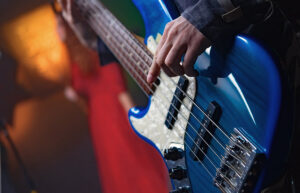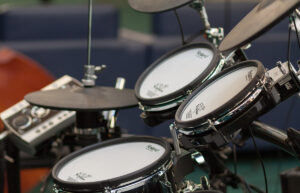Exploring the Diverse Types of Beats in Drumming

As a passionate drummer, I have enjoyed playing various types of beats in drums. I’d like to introduce you to the variations I have successfully implemented in beats to become an accomplished drummer. Explore the types of drum beats, from the steady pulse of rock to the intricate rhythms of Latin music. Let’s dive in and get into the groove of the beat!
Welcome to TheDemoStop, now join the community!
Connect with artists, fans and producers around the world.
Drums beats
Drum beats are the rhythmic backbone of music, providing structure, groove, and momentum. They encompass patterns of hits and accents on drums and percussion instruments, dictating the tempo, feel, and energy of a song. These beats vary in complexity, style, and genre, ranging from simple, steady patterns in rock to intricate, polyrhythmic arrangements found in jazz, funk, and Latin music. Each beat contributes uniquely to the overall character and feel of a musical piece.
Types of beats in drums
Straight 8th beat
The straight 8th beat is a fundamental drumming pattern characterized by a steady and even succession of eighth notes played on the hi-hat or ride cymbal. In this beat, the drummer maintains a consistent rhythm by striking the cymbal on every eighth note count, creating a continuous flow.
Typically used in various genres such as rock, pop, and country music, the straight 8th beat is the foundation for the song’s tempo, providing a driving, consistent feel that keeps the music moving forward. Additionally, the beat complements the other drum elements, like the bass drum and snare hits, to create a cohesive rhythmic structure.
Four to the floor
Four to the floor is a prominent drum beat characterized by a consistent bass drum hit on all four beats of a measure, emphasizing each quarter note (1-2-3-4) in a repetitive and steady pattern. This term originates from the bass drum’s consistent thumping on each downbeat, creating a driving and danceable rhythm.
Commonly associated with various electronic dance music genres such as disco, house, and techno, the four-to-the-floor beat maintains a relentless pulsating groove that encourages movement on the dance floor. It provides a solid foundation and a strong sense of regularity, often complemented by other percussive elements to enhance the energetic feel of the music.
Shuffle groove
The shuffle groove is a distinct and syncopated drumming pattern that infuses a swinging, triplet-based feel into the music. It is characterized by an alternating long-short rhythmic pattern, typically played on the hi-hat or ride cymbal. In this groove, the drummer emphasizes a “shuffle” feel by playing a series of triplets, where the first note is longer or accented, followed by two shorter notes. This creates a distinctive groove that often feels “laid-back” or “swung”, contributing to a relaxed yet driving feel in various music genres such as blues, jazz, rock, and funk. The shuffle groove adds a unique rhythmic texture and a sense of groove that encourages movement and adds depth to the overall musical expression.
16th note beat
The 16th note beat is a rhythmic pattern characterized by a faster and intricate sequence of hits played on the drums or percussion instruments. In this beat, the drummer plays four notes for every beat in a measure, dividing each beat into four equal parts. This results in a rapid succession of hits, offering a higher level of rhythmic complexity and energy compared to slower note patterns.
The 16th note beat is commonly used in various music genres such as rock, funk, and metal to create dynamic and driving rhythms. It provides a sense of urgency and intensity, allowing drummers to add fills, accents, and embellishments, contributing to the overall groove and momentum of the music.
12/8 groove
The 12/8 groove is a rhythmic pattern characterized by a compound meter, dividing each measure into 12 eighth-note subdivisions. In this groove, the drummer emphasizes a series of four groups of three eighth notes each, creating a triplet-based feel within each beat. This results in a rolling, flowing rhythm that feels subdivided into larger pulses, often producing a swaying or swinging sensation.
Commonly found in genres such as blues, jazz, soul, and certain Latin styles, the 12/8 groove provides a rich and expansive feel, allowing for expressive drumming with intricate fills and accents. It adds depth and a sense of fluidity to the music, offering drummers ample opportunities for creative embellishments and syncopated rhythms within its broad, triplet-based structure.
Motown groove
The Motown groove is a distinctive drumming style originating from the Motown Records era of the 1960s. It features a tight, precise, and highly rhythmic pattern that emphasizes a steady backbeat.
The drummers in Motown music often play a consistent snare drum on beats 2 and 4, creating a strong accent that propels the music forward. Additionally, the bass drum is often syncopated, adding a sense of groove and funk to the rhythm. This style is characterized by its simplicity yet effectiveness in driving the song, making it danceable and catchy.
The Motown groove, with its emphasis on precision, helped define the sound of numerous hit songs from the Motown era and remains influential in various genres of music to this day.
Reggae groove
The Reggae groove is a foundational drumming style that underpins the rhythmic essence of reggae music. It’s characterized by its laid-back, offbeat feel, often played on the drum kit. In this groove, the drummer accentures the offbeats, particularly the second and fourth beats of each measure, known as the “skank” or “one drop.” The bass drum typically hits on the third beat, whereas the snare drum usually lands on the third beat as well, but sometimes also on the second and fourth beats.
Reggae’s distinctive rhythm creates a relaxed yet infectious feel through a combination of syncopated accents and space between beats. This groove often incorporates the use of hi-hat patterns, rim shots, and creative variations in the drumming to accentuate the music’s laid-back vibe.
The Reggae groove’s distinctive rhythm and syncopation contribute significantly to the genre’s hypnotic and groove-oriented sound, serving as a cornerstone of reggae music.
Welcome to TheDemoStop, now join the community!
Connect with artists, fans and producers around the world.
Disco beat
The disco beat is a fundamental drumming pattern that played a significant role in defining the sound of disco music during the 1970s. This typically features a four-on-the-floor bass drum pattern, emphasizing all four beats of the measure, providing a steady and danceable pulse. The hi-hat or ride cymbal often plays steady eighth notes, maintaining a consistent rhythm throughout the song.
In addition to the prominent bass drum, the Disco beat commonly incorporates syncopated offbeat snare drum hits, particularly on the second and fourth beats of the measure. This offbeat snare accentuation, along with the continuous four-on-the-floor bass drum, creates an infectious and propulsive groove that encourages dancing. The disco beat’s repetitive yet vibrant rhythm, characterized by its consistent bass drum thumps and syncopated snare hits, became a hallmark of disco music, contributing to its infectious energy and popularity on dance floors worldwide during the disco era.
Jazz ostinato
In jazz music, an ostinato refers to a repeated rhythmic pattern played by one or more instruments, including drums. A jazz ostinato on the drums often involves a repeated phrase or motif that maintains a steady rhythm or groove throughout a piece of music.
Drummers in jazz commonly use ostinatos to establish and maintain the foundational rhythm while allowing for improvisation and interaction with other musicians. These ostinatos can be played on various elements of the drum kit, such as the ride cymbal, hi-hat, or snare drum, creating a consistent pulse and providing a framework for the other musicians to build upon.
The jazz ostinato on drums showcases the drummer’s ability to create a compelling and consistent rhythmic foundation, allowing for improvisation and musical interplay within the jazz ensemble. It serves as a driving force that propels the music forward while allowing for artistic expression and variation.
Half-time shuffle
The half-time shuffle is a distinctive and groovy drumming pattern that gained popularity in various music genres, notably in rock, pop, and funk. It’s characterized by its syncopated and swung feel, dividing the beat into a half-time feel while maintaining a faster tempo. In this beat, the drummer emphasizes a shuffle pattern, typically played on the snare drum and the hi-hat or ride cymbal.
The snare drum hits are offbeats, creating a syncopated rhythm, whereas the bass drum accentuates specific beats, often playing on the first and third beats of the measure or incorporating additional variations. The half-time shuffle has its distinctive groove, achieved by adding ghost notes or lighter hits on the snare drum between the accented beats. This results in a swinging, bouncy feel that is both driving and intricate, contributing to the infectious groove of the music.
FAQs
What are drum beats?
Drum beats are rhythmic patterns created by striking drums and percussion instruments in a specific sequence. They form the foundational rhythm of music, dictating tempo, groove and feel within a song or piece of music.
What are drum beats called?
Drum beats are often referred to simply as rhythms or patterns created by striking drums and percussion instruments in a specific sequence to produce a rhythmic sequence within the music.
What are the different types of drum beats?
- Straight 8th beat
- Four to the floor
- Shuffle groove
- 16th note beat
- 12/8 groove
- Motown groove
- Reggae groove
- Disco beat
- Jazz ostinato
- Half-time shuffle
What is the most common drum beat?
One of the most common drum beats is the “four-on-the-floor” pattern, known for its consistent bass drum hits in all four beats of the measure, often associated with dance and pop music.
What makes a good drum beat?
A good drum beat typically maintains steady timing, complements the music’s style, and provides a solid rhythmic foundation while enhancing the overall feel and groove of the song.
What is the most simple drum beat?
The most simple drum is often a basic pattern with a steady quarter-note bass drum with an accompanying snare drum rattle. This beat is commonly found in various music genres.





























